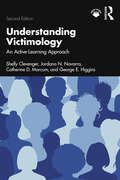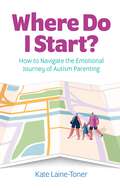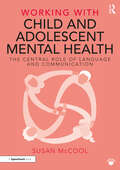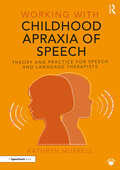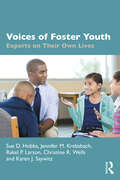- Table View
- List View
Understanding Victimology: An Active-Learning Approach
by Shelly Clevenger Jordana N. Navarro Catherine D. Marcum George E. HigginsUnderstanding Victimology: An Active Learning Approach is the only textbook with extensive discussion of both online and offline victimization reinforced by group and individual learning activities. Our textbook offers instructors a variety of active learning exercises – in the book itself and in the authors’ ancillaries – that engage students in the material and shed light on the experiences of marginalized social groups. Through these activities, students become engaged with the material at a higher level of learning. They learn how victimization happens and the challenges people who experience crime face in acquiring assistance from the criminal-legal system at a more intimate level instead of simply reading about it. Students also build their abilities to work with others in a collaborative learning environment, encouraging professional socialization for the future. The chapters in this second edition address gaps in information typically presented in victimology that ignore prevention or intervention, even though these topics are currently at the forefront of the national conversation going on about sexual violence in higher education. New to this edition are added coverage of immigrants and minorities and new chapters on the media and victimization and on victimization across the gender spectrum, as well as an online instructor resource covering UK case studies, legal framework, and social context that broadens the book’s global appeal. Suitable for undergraduate courses in victimology, this book also serves the needs of sociology and women’s studies courses and can be taught university-wide as part of diversity and inclusion initiatives.
Where Do I Start?: How to navigate the emotional journey of autism parenting
by Kate Laine-TonerRecognising that your child is autistic is a pivotal moment for parents and carers. While it can lead to positives in terms of understanding behaviour and accessing support, the diagnostic process itself can be a huge source of anxiety, stress, guilt and worry.But it's going to be ok - because right here you have the ultimate guidebook to navigating the emotions and challenges that these early stages present.From weathering the initial impact of a potential diagnosis, to self-care strategies and finding new parameters for success, reading this book is like being taken by the hand and shown how to look after your own mental health while supporting your child. Each chapter is full of guidance from someone who's been where you are now, and tells you what you really need to know so you can journey from panic and uncertainty to confidence, acceptance and strength.
Women and Girls on the Autism Spectrum, Second Edition: Understanding Life Experiences from Early Childhood to Old Age
by Sarah Hendrickx Jess HendrickxThe difference that being female makes to the diagnosis, life and experiences of an autistic person is hugely significant. In this widely expanded second edition, Sarah Hendrickx combines the latest research with personal stories from girls and women on the autism spectrum to present a picture of their feelings, thoughts and experiences at each stage of their lives.Outlining the likely impact will be for autistic women and girls throughout their lifespan, Hendrickx surveys everything from diagnosis, childhood, education, adolescence, friendships and sexuality, to employment, pregnancy, parenting, and aging.With up-to-date content on masking, diagnosis later in life, and a new focus on trans and non-binary voices, as well as a deeper dive into specific health and wellbeing implications including menopause, PCOS, Hypermobility/Ehlers-Danlos, autistic burnout, and alexithymia, this is an invaluable companion for professionals, as well as a guiding light for autistic women to understand and interpret their own experience in context.
Women and Girls on the Autism Spectrum, Second Edition: Understanding Life Experiences from Early Childhood to Old Age
by Sarah Hendrickx Jess HendrickxThe difference that being female makes to the diagnosis, life and experiences of an autistic person is hugely significant. In this widely expanded second edition, Sarah Hendrickx combines the latest research with personal stories from girls and women on the autism spectrum to present a picture of their feelings, thoughts and experiences at each stage of their lives.Outlining the likely impact will be for autistic women and girls throughout their lifespan, Hendrickx surveys everything from diagnosis, childhood, education, adolescence, friendships and sexuality, to employment, pregnancy, parenting, and aging.With up-to-date content on masking, diagnosis later in life, and a new focus on trans and non-binary voices, as well as a deeper dive into specific health and wellbeing implications including menopause, PCOS, Hypermobility/Ehlers-Danlos, autistic burnout, and alexithymia, this is an invaluable companion for professionals, as well as a guiding light for autistic women to understand and interpret their own experience in context.
Working with Child and Adolescent Mental Health: The Central Role of Language and Communication (Working With)
by Susan McCoolIn children, mental health challenges and communication differences typically combine in complex and inter-related ways. Remarkably, this crucial point is all too often forgotten, and communication is overlooked. Services are frequently fragmented, leading professionals to look at children through distinct lenses of either mental health or communication, meaning insights can be incomplete and important perspectives unshared. Working with Child and Adolescent Mental Health makes the compelling case that communication is central and should be a primary consideration whenever we think about children’s mental health. With a practical focus, and an easy- to-read format, it suggests how this can be achieved by identifying how practitioners and services can work more cohesively to understand and optimise children’s communication capacities. This book includes: Practical advice, grounded in current research, and presented in an easy-to-read, digestible style Guidance to help practitioners competently and compassionately identify and respond to the needs of children and young people with complex combined communication and mental health needs Real-life case studies from a wide range of settings, unpicked to clearly illustrate topics discussed in the book and offer encouragement and inspiration to practitioners Checklists and questionnaires to help practitioners in daily practice Recommendations for, and links to, useful additional resources Tools to support reflection and enhancement for individual practitioners and services Essential reading for speech and language therapists, psychologists, mental health practitioners, educators, social workers, and anyone else concerned with children’s wellbeing and resilience, this book highlights the transformational impact of placing communication at the heart of all efforts to support children and young people’s mental health.
Working with Child and Adolescent Mental Health: The Central Role of Language and Communication (Working With)
by Susan McCoolIn children, mental health challenges and communication differences typically combine in complex and inter-related ways. Remarkably, this crucial point is all too often forgotten, and communication is overlooked. Services are frequently fragmented, leading professionals to look at children through distinct lenses of either mental health or communication, meaning insights can be incomplete and important perspectives unshared. Working with Child and Adolescent Mental Health makes the compelling case that communication is central and should be a primary consideration whenever we think about children’s mental health. With a practical focus, and an easy- to-read format, it suggests how this can be achieved by identifying how practitioners and services can work more cohesively to understand and optimise children’s communication capacities. This book includes: Practical advice, grounded in current research, and presented in an easy-to-read, digestible style Guidance to help practitioners competently and compassionately identify and respond to the needs of children and young people with complex combined communication and mental health needs Real-life case studies from a wide range of settings, unpicked to clearly illustrate topics discussed in the book and offer encouragement and inspiration to practitioners Checklists and questionnaires to help practitioners in daily practice Recommendations for, and links to, useful additional resources Tools to support reflection and enhancement for individual practitioners and services Essential reading for speech and language therapists, psychologists, mental health practitioners, educators, social workers, and anyone else concerned with children’s wellbeing and resilience, this book highlights the transformational impact of placing communication at the heart of all efforts to support children and young people’s mental health.
Working with Childhood Apraxia of Speech: Theory and Practice for Speech and Language Therapists (Working With)
by Kathryn MurrellThis resource will lead the reader through the practicalities of assessment, diagnosis, and therapeutic intervention for children of all ages with features of childhood apraxia of speech. It provides the theory and underlying principles upon which to work with children who have this fascinating but challenging disorder in collaboration with families and schools.Chapters are clearly laid out, with hands on activities for intervention and helpful summaries. There is a focus on alternative and augmentative means of communication and multidisciplinary working, as well as a wealth of case studies and teaching notes for training other professionals. Fresh ways of working are addressed, such as the use of teletherapy and other techniques such as group therapy and the consultative approach are discussed.Key features include: A theoretical overview of current thinking about childhood apraxia of speech A structured assessment format with a chapter specifically focused on how to take a detailed speech sample Clear guidance on how to make a differential diagnosis How to spot early indicators of childhood apraxia of speech Advice sheets for parents and schools Downloadable record forms for case history taking and assessment. This book can be read cover to cover or dipped into for quick and easy therapy ideas and is presented in an easy-to-read format, with chapters broken down into bite-sized chunks. It is an essential handbook for all speech and language therapists and students, whatever their level of experience.
Working with Childhood Apraxia of Speech: Theory and Practice for Speech and Language Therapists (Working With)
by Kathryn MurrellThis resource will lead the reader through the practicalities of assessment, diagnosis, and therapeutic intervention for children of all ages with features of childhood apraxia of speech. It provides the theory and underlying principles upon which to work with children who have this fascinating but challenging disorder in collaboration with families and schools.Chapters are clearly laid out, with hands on activities for intervention and helpful summaries. There is a focus on alternative and augmentative means of communication and multidisciplinary working, as well as a wealth of case studies and teaching notes for training other professionals. Fresh ways of working are addressed, such as the use of teletherapy and other techniques such as group therapy and the consultative approach are discussed.Key features include: A theoretical overview of current thinking about childhood apraxia of speech A structured assessment format with a chapter specifically focused on how to take a detailed speech sample Clear guidance on how to make a differential diagnosis How to spot early indicators of childhood apraxia of speech Advice sheets for parents and schools Downloadable record forms for case history taking and assessment. This book can be read cover to cover or dipped into for quick and easy therapy ideas and is presented in an easy-to-read format, with chapters broken down into bite-sized chunks. It is an essential handbook for all speech and language therapists and students, whatever their level of experience.
Disabling Migration Controls: Shared Learning, Solidarity, and Collective Resistance (ISSN)
by Rebecca YeoWhen people are prevented from meeting their needs, the impact is disabling, whether in the immigration system or in the wider population. Drawing on many years of research and activism, this book argues that insights from the disabled people’s movement, particularly the original Social Model of Disability, can be usefully extended to focus resistance on the disabling restrictions imposed on people subject to asylum and immigration controls.While acknowledging the pain and discomfort of many impairments and of forced displacement, the book focuses on injustices that can be changed. It does not catalogue the hostility of the ‘hostile environment’. Nor does it promote inclusive asylum restrictions. An unjust system is not transformed by including disabled people. Policies designed to deprive people of essential needs and to stoke hatred among the wider population are core elements of the rise of fascism. In this context, bringing together movements for disability and migrant justice could help build urgently needed solidarity and resistance with which to develop a society based on equity and common humanity.Quotations and images are used to convey the messages and priorities of disabled people seeking asylum, ensuring that the book is both engaging and grounded in the insights of lived experience. This book will interest people seeking to improve social justice, including scholars of disability, migration, sociology and politics.
Disabling Migration Controls: Shared Learning, Solidarity, and Collective Resistance (ISSN)
by Rebecca YeoWhen people are prevented from meeting their needs, the impact is disabling, whether in the immigration system or in the wider population. Drawing on many years of research and activism, this book argues that insights from the disabled people’s movement, particularly the original Social Model of Disability, can be usefully extended to focus resistance on the disabling restrictions imposed on people subject to asylum and immigration controls.While acknowledging the pain and discomfort of many impairments and of forced displacement, the book focuses on injustices that can be changed. It does not catalogue the hostility of the ‘hostile environment’. Nor does it promote inclusive asylum restrictions. An unjust system is not transformed by including disabled people. Policies designed to deprive people of essential needs and to stoke hatred among the wider population are core elements of the rise of fascism. In this context, bringing together movements for disability and migrant justice could help build urgently needed solidarity and resistance with which to develop a society based on equity and common humanity.Quotations and images are used to convey the messages and priorities of disabled people seeking asylum, ensuring that the book is both engaging and grounded in the insights of lived experience. This book will interest people seeking to improve social justice, including scholars of disability, migration, sociology and politics.
Voices of Foster Youth: Experts on Their Own Lives
by Karen J. Saywitz Sue D. Hobbs Jennifer M. Krebsbach Rakel P. Larson Christine R. WellsThis important book offers unique insight into the experience of foster youth from 27 countries around the world. It provides a systematic review of literature reporting the experiences of youth in care, addressing a wide range of key topics in this multidisciplinary field, and presenting the views and perceptions of these young people.Including a meta-analysis on contact with birth parents, it examines youth’s experiences of the foster care system; contact and relationships; caregiving and relationships with caregivers; placements; and emotional well-being. These five core themes embrace a wide range of crucial topics including foster youth’s involvement in decisions about themselves; interactions with social workers, birth families, foster families, peers, and friends; the benefits and challenges of foster care; the stigma attached to being in care; mental health, well-being, and belonging; and developing a sense of self.This essential volume is for students and scholars of child and adolescent development, social work, education, sociology, and public health. Illustrated with quotes from former and current foster youth, and with research-based recommendations for best practices in foster care, it is also for professional social workers, psychologists, child advocates, children’s therapists, children’s attorneys, youth workers, and foster parents.
